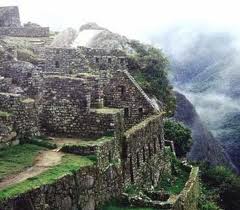


MACHU PICCHU: PERU'S LOST CITY
By Kristina Morgan
"To visit Machu Picchu, you must prepare the soul, sharpen the senses. Forget for some minutes, the small and transcendental problems of our lives, of modern man..." Napoleon Polo Casilla 435 Cuzco Peru
This ancient citadel is still a mystery, even after it was discovered 100 years ago. The city, which was quickly vacated, still stands today…an Incan ghost town with a spiritual pulse which draws thousands of visitors each year.
Whether you are feasting on sumptuous seafood in Lima or exploring the ruins at Machu Picchu, one of the Seven Wonders of the World, this is the trip of a lifetime and is said to be the travel destination that appears on more “bucket lists” than any other.
"To visit Machu Picchu, you must prepare the soul, sharpen the senses. Forget for some minutes, the small and transcendental problems of our lives, of modern man..." Napoleon Polo Casilla 435 Cuzco Peru
This ancient citadel is still a mystery, even after it was discovered 100 years ago. The city, which was quickly vacated, still stands today…an Incan ghost town with a spiritual pulse which draws thousands of visitors each year.
Whether you are feasting on sumptuous seafood in Lima or exploring the ruins at Machu Picchu, one of the Seven Wonders of the World, this is the trip of a lifetime and is said to be the travel destination that appears on more “bucket lists” than any other.
Karen Binson says, “Dreams can come true! We got up at 4am to get in line for the march to Machu Picchu to see the sunrise. The first glimpse through the Sun Gate after more than 10 years of yearning and several failed attempts to get there was quite emotional. It was more beautiful and spectacular than I'd ever imagined and I could have looked upon that view for hours. The city itself is much more impressive and extensive than Choquequirao. The dense jungle covered mountains that surround it are beautiful. Photos cannot capture the 360 degree views. It is far more breath-taking than any other ruins we have ever seen. It's so hidden away it's no wonder the Spanish never found it.”
The first known American to see Choquequirao was the young Yale history lecturer Hiram Bingham III, in 1909. He was researching a biography of the South American liberator Simón Bolívar when a local prefect he met near Cuzco persuaded him to visit the site. Many believed that the ruins of Choquequirao had once been Vilcabamba, the legendary lost city of the Incas. Bingham didn’t agree and was mesmerized by the idea of lost cities waiting to be found. Two years later, he returned to Peru in search of Vilcabamba. On July 24, 1911, just days into his expedition, Bingham climbed a 2,000-foot-tall slope and encountered an abandoned stone city of which no record existed. It was Machu Picchu.
The first known American to see Choquequirao was the young Yale history lecturer Hiram Bingham III, in 1909. He was researching a biography of the South American liberator Simón Bolívar when a local prefect he met near Cuzco persuaded him to visit the site. Many believed that the ruins of Choquequirao had once been Vilcabamba, the legendary lost city of the Incas. Bingham didn’t agree and was mesmerized by the idea of lost cities waiting to be found. Two years later, he returned to Peru in search of Vilcabamba. On July 24, 1911, just days into his expedition, Bingham climbed a 2,000-foot-tall slope and encountered an abandoned stone city of which no record existed. It was Machu Picchu.

One’s first view of Machu Picchu is a bit like seeing the Mona Lisa after staring for years at a da Vinci refrigerator magnet. You know exactly what to expect, and at the same time, can’t quite believe that the real thing exceeds the hype. Also like the Mona Lisa, Machu Picchu is more compact than it appears in photos. In less than an hour I was able to visit most of the ruins that Bingham saw 100 years ago, in the same order he had encountered them: the cave of the Royal Mausoleum, with its interior walls that seemed to have melted; the perfect curve of the Sun Temple; the titanic structures of the Sacred Plaza, assembled from what Bingham called “blocks of Cyclopean size, higher than a man” and at the very top of the main ruins, the enigmatic Intihuatana stone, around which a throng of mystically inclined visitors stood with their hands extended, hoping to absorb any good vibrations radiating from the granite.
Upon hiking various trails we also met a herd of llamas that were not at all disturbed by our presence. It felt transcendental itself to walk up to a mother llama and her calf and be able to stroke them as they nuzzled my hand before retreating with the rest of the herd. One thing I knew after my time at Machu Picchu is that it exceeded every expectation I had.
Upon hiking various trails we also met a herd of llamas that were not at all disturbed by our presence. It felt transcendental itself to walk up to a mother llama and her calf and be able to stroke them as they nuzzled my hand before retreating with the rest of the herd. One thing I knew after my time at Machu Picchu is that it exceeded every expectation I had.


